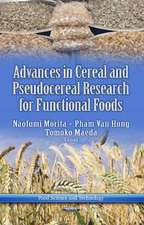Engineering Principles of Unit Operations in Food Processing: Unit Operations and Processing Equipment in the Food Industry
Editat de Seid Mahdi Jafarien Limba Engleză Paperback – 24 iun 2021
- Brings new opportunities in the optimization of food processing operations
- Thoroughly explores applications of food engineering to food processes
- Focuses on unit operations from an engineering viewpoint
Preț: 1145.50 lei
Preț vechi: 1488.56 lei
-23% Nou
Puncte Express: 1718
Preț estimativ în valută:
219.22€ • 228.02$ • 180.98£
219.22€ • 228.02$ • 180.98£
Carte tipărită la comandă
Livrare economică 07-21 aprilie
Preluare comenzi: 021 569.72.76
Specificații
ISBN-13: 9780128184738
ISBN-10: 0128184736
Pagini: 498
Ilustrații: Approx. 100 illustrations
Dimensiuni: 216 x 276 x 35 mm
Greutate: 1.14 kg
Editura: ELSEVIER SCIENCE
ISBN-10: 0128184736
Pagini: 498
Ilustrații: Approx. 100 illustrations
Dimensiuni: 216 x 276 x 35 mm
Greutate: 1.14 kg
Editura: ELSEVIER SCIENCE
Public țintă
: food engineers, undergraduate and graduate students in Food Science and Technology, and also, for technologists, researchers, and all the people concerned with food processing operationsCuprins
1. Introduction to unit operations and process description
Section 1 Fundamentals of food process engineering
2. Units and dimensions
3. General mathematical and engineering principles
4. Physical properties of food materials
5. Thermodynamic properties of food materials
6. Mass and energy balances
Section 2 Fluid mechanics and food rheology
7. Fluid mechanics
8. Rheological properties of food materials
Section 3 Heat and mass transfer in food engineering
9. Conductive heat transfer
10. Convective heat transfer
11. Radiative heat transfer
12. Fundamentals of mass transfer
13. Psychrometry
Section 4 Application of mathematics and statistical approaches in food engineering
14. Modeling and optimization
15. Reaction kinetics
Section 1 Fundamentals of food process engineering
2. Units and dimensions
3. General mathematical and engineering principles
4. Physical properties of food materials
5. Thermodynamic properties of food materials
6. Mass and energy balances
Section 2 Fluid mechanics and food rheology
7. Fluid mechanics
8. Rheological properties of food materials
Section 3 Heat and mass transfer in food engineering
9. Conductive heat transfer
10. Convective heat transfer
11. Radiative heat transfer
12. Fundamentals of mass transfer
13. Psychrometry
Section 4 Application of mathematics and statistical approaches in food engineering
14. Modeling and optimization
15. Reaction kinetics

























